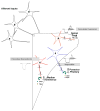The paraventricular nucleus of the hypothalamus - a potential target for integrative treatment of autonomic dysfunction
- PMID: 18479218
- PMCID: PMC2682920
- DOI: 10.1517/14728222.12.6.717
The paraventricular nucleus of the hypothalamus - a potential target for integrative treatment of autonomic dysfunction
Abstract
Background: The paraventricular nucleus of the hypothalamus (PVN) has emerged as one of the most important autonomic control centers in the brain, with neurons playing essential roles in controlling stress, metabolism, growth, reproduction, immune and other more traditional autonomic functions (gastrointestinal, renal and cardiovascular).
Objectives: Traditionally the PVN was viewed as a nucleus in which afferent inputs from other regions were faithfully translated into changes in single specific outputs, whether neuroendocrine or autonomic. Here we present data which suggest that the PVN plays significant and essential roles in integrating multiple sources of afferent input and sculpting an integrated autonomic output by concurrently modifying the excitability of multiple output pathways. In addition, we highlight recent work that suggests that dysfunction of such intranuclear integrative circuitry contributes to the pathology of conditions such as hypertension and congestive heart failure.
Conclusions: This review highlights data showing that individual afferent inputs (subfornical organ), signaling molecules (orexins, adiponectin), and interneurons (glutamate/GABA), all have the potential to influence (and thus coordinate) multiple PVN output pathways. We also highlight recent studies showing that modifications in this integrated circuitry may play significant roles in the pathology of diseases such as congestive heart failure and hypertension.
Figures



Similar articles
-
Angiotensinergic regulation of autonomic and neuroendocrine outputs: critical roles for the subfornical organ and paraventricular nucleus.Neuroendocrinology. 2009;89(4):370-6. doi: 10.1159/000211202. Epub 2009 Apr 3. Neuroendocrinology. 2009. PMID: 19342823 Review.
-
The paraventricular nucleus and heart failure.Exp Physiol. 2014 Feb;99(2):332-9. doi: 10.1113/expphysiol.2013.072678. Epub 2013 Dec 6. Exp Physiol. 2014. PMID: 24317407 Review.
-
[Central action of orexins on sympathetic outflow and cardiovascular function with a focus on the paraventricular nucleus of the hypothalamus].Masui. 2007 Jan;56(1):30-9. Masui. 2007. PMID: 17243643 Review. Japanese.
-
Neuroanatomical organization and functional roles of PVN MC4R pathways in physiological and behavioral regulations.Mol Metab. 2022 Jan;55:101401. doi: 10.1016/j.molmet.2021.101401. Epub 2021 Nov 22. Mol Metab. 2022. PMID: 34823066 Free PMC article.
-
Regulation of sympathetic vasomotor activity by the hypothalamic paraventricular nucleus in normotensive and hypertensive states.Am J Physiol Heart Circ Physiol. 2018 Nov 1;315(5):H1200-H1214. doi: 10.1152/ajpheart.00216.2018. Epub 2018 Aug 10. Am J Physiol Heart Circ Physiol. 2018. PMID: 30095973 Free PMC article. Review.
Cited by
-
Central neuromodulatory pathways regulating sympathetic activity in hypertension.J Appl Physiol (1985). 2012 Oct 15;113(8):1294-303. doi: 10.1152/japplphysiol.00553.2012. Epub 2012 Jul 5. J Appl Physiol (1985). 2012. PMID: 22773773 Free PMC article. Review.
-
Enhanced activation of RVLM-projecting PVN neurons in rats with chronic heart failure.Am J Physiol Heart Circ Physiol. 2012 Apr 15;302(8):H1700-11. doi: 10.1152/ajpheart.00722.2011. Epub 2012 Feb 3. Am J Physiol Heart Circ Physiol. 2012. PMID: 22307669 Free PMC article.
-
Activation of oxytocinergic neurons enhances torpor in mice.J Comp Physiol B. 2024 Feb;194(1):95-104. doi: 10.1007/s00360-023-01528-y. Epub 2024 Jan 3. J Comp Physiol B. 2024. PMID: 38170253
-
Preclinical models for obesity research.Dis Model Mech. 2016 Nov 1;9(11):1245-1255. doi: 10.1242/dmm.026443. Dis Model Mech. 2016. PMID: 27821603 Free PMC article. Review.
-
Shining light on the paraventricular nucleus: the role of glutamatergic PVN neurons in blood pressure control.J Physiol. 2018 Dec;596(24):6127-6128. doi: 10.1113/JP277043. Epub 2018 Oct 23. J Physiol. 2018. PMID: 30300451 Free PMC article. No abstract available.
References
-
- Swanson LW, Sawchenko PE. Paraventricular nucleus: a site for the integration of neuroendocrine and autonomic mechanisms. Neuroendocrinology. 1980;31:410–417. - PubMed
-
- Buijs RM, van Eden CG, Goncharuk VD, Kalsbeek A. The biological clock tunes the organs of the body: timing by hormones and the autonomic nervous system. J Endocrinol. 2003;177:17–26. - PubMed
-
- Coote JH. Cardiovascular function of the paraventricular nucleus of the hypothalamus. Biol Signals. 1995;4:142–149. - PubMed
-
- Kalra SP, Dube MG, Pu S, Xu B, Horvath TL, Kalra PS. Interacting appetite-regulating pathways in the hypothalamic regulation of body weight. Endocr Rev. 1999;20:68–100. - PubMed
-
- Williams G, Harrold JA, Cutler DJ. The hypothalamus and the regulation of energy homeostasis: lifting the lid on a black box. Proc Nutr Soc. 2000;59:385–396. - PubMed
Publication types
MeSH terms
Grants and funding
LinkOut - more resources
Full Text Sources
Medical
